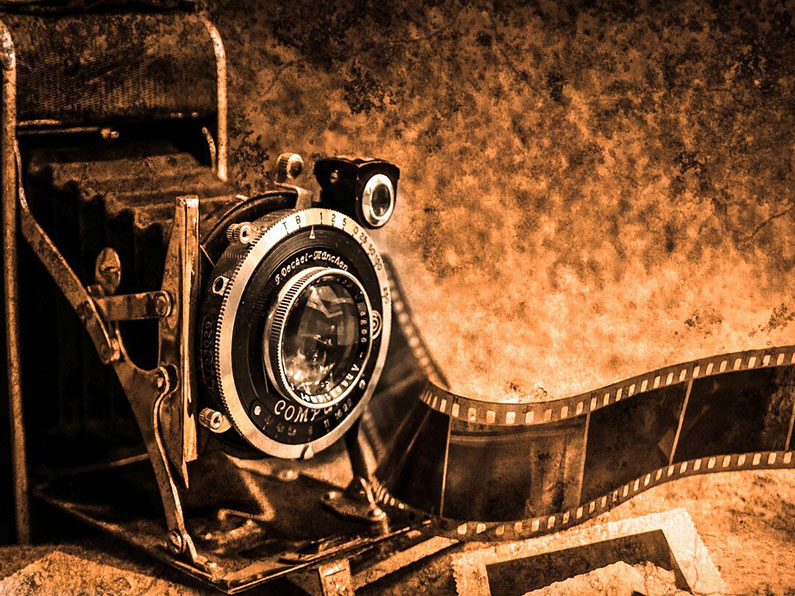The Birth of Photography
A talk given by Terence Sackett at the Thomas Poole Library
Terence Sackett gave a lavishly illustrated talk in the Thomas Poole Library about the birth of photography with its trials and triumphs: from the first human being ever to be photographed to the popular picture postcard.
He began by pointing out how easy we have it today, with our digital cameras and mobile phones. They focus automatically and usually give the correct exposure. And we can view the results immediately afterwards on a screen. It wasn’t always like this.
Photography might have begun with Coleridge’s friend Tom Wedgwood, who experimented with chemicals and a camera obscura in the late 1790s. In spite of his efforts his images faded straightaway.
The Frenchman Louis Daguerre made the first serious breakthrough in the 1830s with his invention of the daguerreotype – beautifully detailed images on copper plates. But you would have had to sit for up to twenty minutes without moving or twitching. If you did the photographer would have had to start all over again.
Real progress was made much closer to home in Lacock, Wiltshire, by the scientist and inventor Fox Talbot in the 1840s. What was so ground-breaking about Talbot’s paper calotype negatives was that copies could be made of them. But they were never as beautifully clear as the dageurrotype because of the grain in the paper showing through.
It was not until 1851, when Scott Archer invented the wet collodion process, that photography came of age. Negative images from a bellows camera were cast on glass plates that could be up to twenty inches in size. The process could be fraught: the plates had to be coated, exposed, and developed within a short time, so photographers had to have mobile darkrooms.
The adventurer Francis Frith was one of the first photographers to truly test the collodion process to its limits. He made three pioneering expeditions to the Middle East, venturing 1500 miles up the Nile, taking photographs of the monuments and landscapes. The conditions he faced were arduous. He battled with robbers, developed some of his prints in a tomb at the foot of the Great Pyramid, and worked with dangerous chemicals that sizzled on the glass plates in the searing desert heat of the Nile. But the results proved a sensation when he returned to England, and instantly made his reputation.
Photography now showed its true potential in a range of applications. In the 1870s John Thomson recorded the street life of the poor in London, and photographers captured harrowing images of child labour that helped to encourage the spread of philanthropy. Roger Fenton was commissioned to record the horrors of the Crimean War and Matthew Brady the American Civil War, both photographers risking life and limb to capture the reality of conflict.
The Victorian age was marked by massive leaps in industry and engineering, and Terence showed images of the stages in construction of Isambard Kingdom Brunel’s steamship the ‘Great Eastern’.
The potential of photography obsessed artists. They could not ignore it. Julia Margaret Cameron aped Rembrandt in her high art portraits of sitters such as Charles Darwin and Lord Tennyson. Henry Peach Robinson created prints made from combining up to a dozen different glass plate negatives. He believed that photography should have the same status as oil painting. We were shown one particular Robinson photograph – created from five separate negatives – of an old Darby and Joan couple in their country cottage, enjoying a quiet moment in the twilight of their lives. But it’s believed that they had never met!
The last part of the talk was all about Francis Frith’s later achievements. The spread of the railways and Bank Holidays allowed the working man and his family to enjoy days out. Frith foresaw that these new working class tourists would enjoy having photo souvenir prints to commemorate their holidays. He set up a photo business in Reigate, and travelled all over the country photographing seaside scenes, beauty spots, town centres and villages. Terence showed a fascinating sequence of photographs of Cleeve Abbey taken before the Luttrell’s restoration when it was in use as a farmyard.
In 1902 the Post Office approved the use of postcards with a divided back. This led to the introduction of the picture postcard, and Frith & Co were in the vanguard of its development for the next fifty years.
Terence ended by reminding us that each photo depicts real people, in a real place, at a particular moment in time. It is this extraordinary particularity that differentiates photographs from paintings. It gives them their unique status as historical documents of fundamental importance. They are a vital source of social history, but also much, much more.

